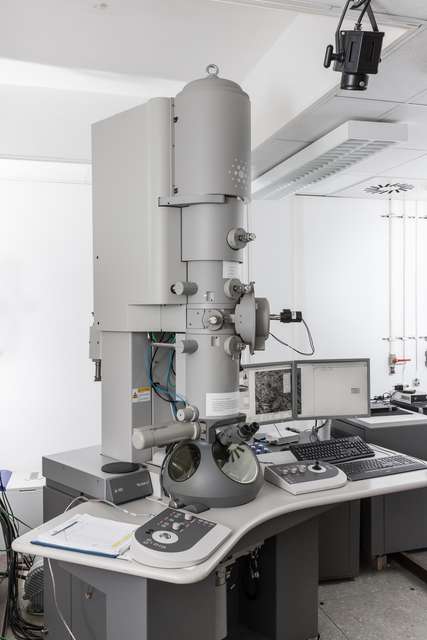FEI Tecnai G2 F20 (Tecnai)
Jülich
The FEI Titan Tecnai G2 F20 is a versatile transmission electron microscope which is equipped with a Gatan Tridiem 863P post column image filter (GIF) and a high angle energy dispersive X-ray (EDX) detector. This set up allows for a variety of experiments such as conventional imaging and diffraction, recording of bright- and dark-field scanning transmission electron microscopy (STEM) images, or acquiring elemental maps extracted from energy electron loss spectra (EELS) or EDX signals.
Typical Applications and Limitations of Use
Since the FEI Tecnai G2 F20 is not equipped with any Cs corrector its resolution is limited to 2.4 Å in TEM mode (point to point resolution) and 1.9 Å in STEM mode. However, the large tilt angles of the specimen stage (see chapter 5 below) and the EELS and EDX capabilities make this instrument attractive for medium resolution work, e.g. for analyses of diffraction contrast and diffraction patterns or for determination of the chemical composition on the nanometer scale by electron energy loss spectroscopy, energy filtered transmission electron microscopy (EFTEM) or energy dispersive X-ray analyses.
Sample Environment
Samples are investigated either under room temperature or liquid nitrogen cooling conditions at a vacuum level of about 10–8 mbar. Besides this standard setup, the sample environment can be adapted to various conditions, e.g. the thermal treatment or the application of external electric or magnetic fields to samples, making use of a wide portfolio of in situ TEM holders available through the ER-C user services. In general, all types of materials can be investigated which do not harm the microscope and the specimen holders and which obey the ER-C’s safety rules.
Publications
Thermal Facet Healing of Concave Octahedral Pt–Ni Nanoparticles Imaged in Situ at the Atomic Scale: Implications for the Rational Synthesis of Durable High-Performance ORR Electrocatalysts
Gan L, Heggen M, Cui C, Strasser P - ACS Catalysis - 2015
Structural and electronic properties ofβ-FeSi2nanoparticles: The role of stacking fault domains
Imlau R, Kovács A, Mehmedovic E, Xu P, Stewart A, Leidinger C, Dunin-Borkowski R, Bihlmayer G, Wiggers H, Carius R, Kolb U, Luysberg M - Physical Review B - 2014
High CO2Selectivity in Methanol Steam Reforming through ZnPd/ZnO Teamwork
Friedrich M, Penner S, Heggen M, Armbrüster M - Angewandte Chemie - 2013
Molecular Beam Epitaxy Growth of GaAs/InAs Core–Shell Nanowires and Fabrication of InAs Nanotubes
Rieger T, Luysberg M, Schäpers T, Grützmacher D, Lepsa M - Nano Letters - 2012
Link: https://er-c.org/index.php/access/
